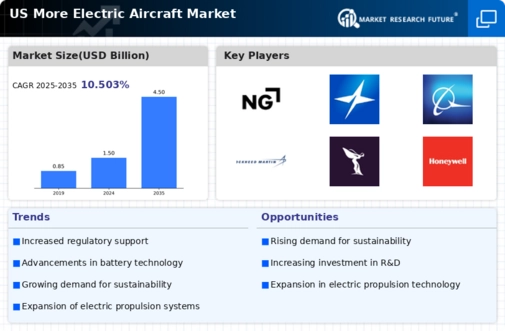Advancements in Battery Technology
Battery technology advancements are pivotal for the more electric-aircraft market. The development of high-capacity, lightweight batteries is crucial for enhancing the range and efficiency of electric aircraft. Recent innovations, such as solid-state batteries, promise to increase energy density while reducing weight, which is essential for aviation applications. The U.S. Department of Energy has reported that improvements in battery performance could lead to a 30% increase in range for electric aircraft by 2027. This technological progress not only enhances operational capabilities but also reduces operational costs, making electric aircraft more competitive. As battery technology continues to evolve, is likely to experience accelerated growth and adoption.
Environmental Sustainability Initiatives
is increasingly driven by the growing emphasis on environmental sustainability. As climate change concerns escalate, the aviation industry faces mounting pressure to reduce its carbon footprint. The U.S. government has set ambitious targets to cut greenhouse gas emissions by 50% by 2030, which has led to increased investments in electric aircraft technologies. This shift is not only a response to regulatory demands but also aligns with consumer preferences for greener travel options. is expected to benefit from these initiatives, as airlines and manufacturers seek to innovate and adopt cleaner technologies. Furthermore, the market could see a potential growth rate of 15% annually as stakeholders prioritize sustainable practices.
Investment in Infrastructure Development
Infrastructure development is a critical driver for the more electric-aircraft market. The establishment of charging stations and maintenance facilities tailored for electric aircraft is essential for their widespread adoption. The U.S. government has initiated funding programs aimed at enhancing aviation infrastructure, with a focus on integrating electric aircraft into existing systems. For instance, the Federal Aviation Administration (FAA) has allocated $200 million for projects that support electric aviation infrastructure. This investment is expected to facilitate the transition to electric aircraft, as it addresses logistical challenges and enhances operational efficiency. Consequently, the more electric-aircraft market is poised for growth as infrastructure improvements pave the way for increased adoption.
Government Incentives and Funding Programs
Government incentives and funding programs play a significant role in propelling the more electric-aircraft market. The U.S. government has introduced various initiatives aimed at promoting the development and adoption of electric aviation technologies. For example, the Sustainable Aviation Fuel Grand Challenge aims to accelerate the commercialization of sustainable aviation fuels, which complements electric aircraft initiatives. Furthermore, grants and tax incentives for research and development in electric aircraft technologies are becoming more prevalent. These financial supports not only lower the barriers to entry for manufacturers but also stimulate innovation within the industry. As a result, the more electric-aircraft market is likely to experience robust growth driven by these supportive government measures.
Consumer Demand for Innovative Travel Solutions
Consumer demand for innovative travel solutions is reshaping the more electric-aircraft market. As travelers become more environmentally conscious, there is a growing preference for sustainable travel options. Surveys indicate that over 60% of U.S. travelers are willing to pay a premium for eco-friendly flights. This shift in consumer behavior is prompting airlines to explore electric aircraft as a viable alternative to traditional jets. The more electric-aircraft market stands to gain from this trend, as airlines seek to differentiate themselves by offering greener travel experiences. Additionally, the potential for reduced noise pollution and lower operating costs further enhances the appeal of electric aircraft, aligning with consumer expectations for modern air travel.






















Leave a Comment